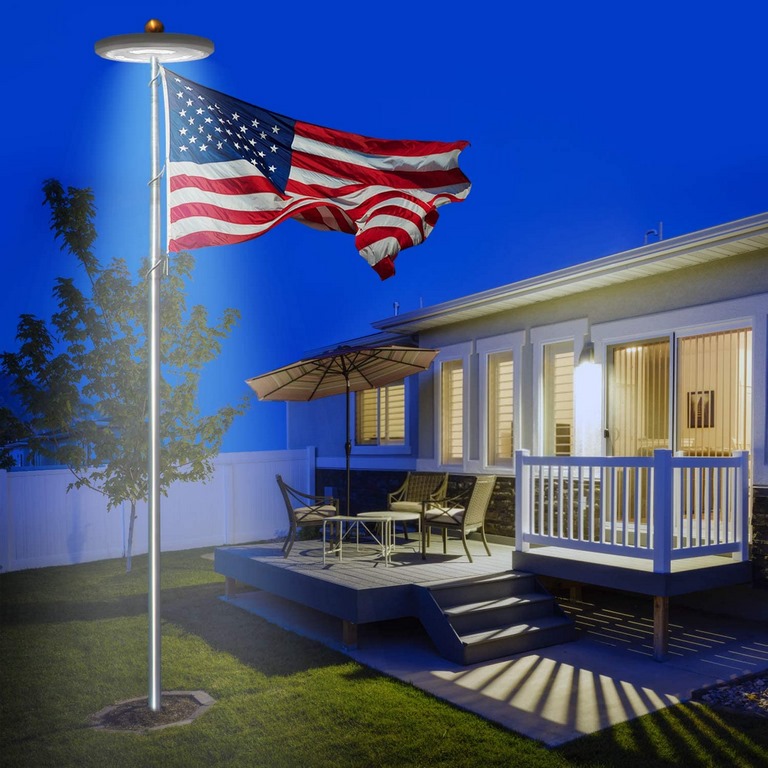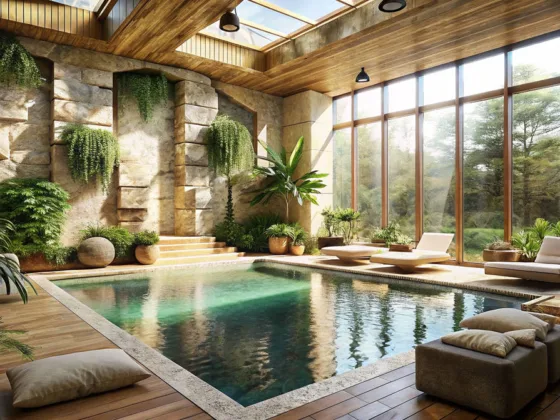Table of Contents Show
Tastefully adequate flagpole lighting doesn’t only add aesthetic “wow” appeal to your home landscaping decore.
In the case of the American flag, it’s an often little-known legal requirement. The US National Flag Code states, and we quote, “It is the universal custom to display the flag only from sunrise to sunset on buildings and stationary flagstaffs in the open. However, when a patriotic effect is desired, the flag may be displayed twenty-four hours a day if properly illuminated during the hours of darkness.”
Essentially, this means you may only fly the Stars and Stripes after dark if the flag pole is properly lit. Now, there are a bunch of ways to do this. You can either use existing landscaping lighting to create ambient illumination or install dedicated flagpole lighting.
Of course, in keeping with global green and cost-saving trends, solar lighting is certainly the most popular way of doing this. Let’s have a closer look at how to properly light up Old Glory.
Flagpole Lighting: The Aesthetics and the Legal Implications
The WOW Factor
A well-illuminated flag pole is a thing of beauty in any front yard, or anywhere else for that matter.
And solar landscape and flag pole lighting are arguably the best way of leveraging that impact.
Installing a solar flagpole light is the easiest and often the cheapest way of giving the flag the respect it deserves.
The Law
On December 22, 1942, the then US National Flag Use and Display guidelines were written into Federal law.
Now the National Flag Code serves as a guideline to the correct handling and display of the American flag.
That code has served since as a foundation for state laws regarding the US flag and its use.
And it is pretty specific about the requirements for flying the flag after dark.
The foundation of these requirements is the “proper illumination” of the flag during the hours of darkness.
So, what constitutes concepts like these? The Cornell Law School has the following to say regarding the proper illumination of the flag. We quote, “a light specifically placed to illuminate the flag (preferred) or having a light source sufficient to illuminate the flag so it is recognizable as such by the casual observer”.
A clear interpretation of the term is found in the Washington State Legislature’s Revised Code of Washington (RCW). In section 46.04.200 the code states and we quote, “Hours of darkness means the hours from one-half hour after sunset to one-half hour before sunrise, and any other time when persons or objects may not be clearly discernible at a distance of five hundred feet”.
In layman’s terms, at around sunset, you have to light the Star-Spangled Banner up well and properly.
The Three Best Ways to Light Your Flagpole
Although there are many different ways of illuminating a flagpole, these are the three most popular and effective solutions.
All are low-power, environmentally friendly solutions that focus on the importance of solar energy.
- Focused uplighting
- Ambient floodlighting
- Pole top lights
Focused Uplighting
Focused pin spots and directional floodlights are all base-of-pole solar flagpole uplighting fixtures.
They are either mounted directly under the flag pole and direct their beam spread lighting vertically.
Or they are mounted within 10 feet of the pole and light up the flag diagonally.
The number of spots or floodlights you use will largely depend on the height of the pole.
Generally, flagpoles of 25 feet or less will require two lights placed around 10′ from the pole and 180° apart.
Taller poles would benefit from a three-light layout at the same spacing and located 120° apart.
These guidelines are based on fittings with an approximate beam spread of 15°.
Some solar uplights attach to the pole itself and are directed vertically to illuminate the flag from below. These are, however, not always compatible with telescoping flagpoles.
Ambient Floodlighting
Ambient lighting is sometimes the most effective and striking option. Especially if the flagpole is the centerpiece of a larger garden feature.
Ambient floodlighting is most effective when the lighting sources are located fairly high off the ground.
For example, light fixtures on balconies, lamp posts, or under the eaves of the home’s second story.
The same can be said for 45° building-mounted flagpoles. These are far easier to illuminate with ambient lighting.
Pole Top Solar Flagpole Lights
These fittings are among the most effective and visually appealing ways to keep Old Glory illuminated during the hours of darkness.
They are typically mounted at the top of the pole directly under the pole top ornament.
Featuring a solar panel on the light cover, they direct a wide beam of light directly down onto the flag’s arc.
Just try and keep in mind that. in strong winds, the flag extends straight out from the pole.
So, if your flag is 5 feet wide, your lighting has to cover a 10-foot area around the pole.
Additional Considerations
For the most part, the lighting you’ll use to light your flagpole will be pretty bright.
In addition, most residential flagpoles are in the front yard. When choosing positions for your flagpole lighting, be conscious of the effect they may have on your neighbors.
And make certain they don’t pose any blinding risks for traffic in the streets around your house.
Paying respect to the Stars and Stripes shouldn’t come at the cost of the comfort or safety of others.
The Conclusion
Flag poles are not only a symbol and source of national pride but make striking landscaping features.
And illuminating them well is worth any effort that goes into getting it done. And with solar lighting, getting it done won’t impact your energy bill.
So, if that patriotic effect is desired the flag may be displayed not only from sunrise to sunset.
It can be displayed 24 hours a day if properly illuminated. Even if it is the universal custom to display the flag only from sunrise to sunset!














